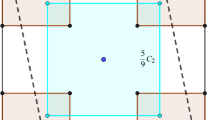Abstract
Given a triangulation of a point set on the plane, dilation of any pair of the points is the ratio of their shortest path length to their Euclidean distance. The maximum dilation over all pairs of points is called the dilation of this triangulation. Minimum dilation triangulation problem seeks a triangulation with the least possible dilation of an input point set. For this problem no polynomial time algorithm is known. We present an exact algorithm based on a branch and bound method for finding minimum dilation triangulations. This deterministic algorithm after generating an initial solution, iteratively computes a lower bound for the answer and then applies a branch and bound method to find a better solution. It also uses a local search method to improve the initial solution and the obtained solution of the branch and bound method. We implemented our algorithm and conducted computational experiments on some benchmark instances. The efficacy of the approach is demonstrated by comparing its results with two other published methods.


Similar content being viewed by others
References
Amani, M., Biniaz, A., Bose, P., De Carufel, J. L., Maheshwari, A., Smid, M.: A plane 1.88-spanner for points in convex position. In: Proceedings of the 15th Scandinavian Symposium and Workshops on Algorithm Theory, SWAT 2016, pp. 25:1–25:14. Reykjavik, Iceland (2016)
Bose, P., Devroye, L., Löffler, M., Snoeyink, J., Verma, V.: Almost all Delaunay triangulations have stretch factor greater than \(\pi /2\). Comput. Geom. 44(2), 121–127 (2011)
Brandt, A.F., Gaiowski, M.M., de Souza, C.C., de Rezende, P.J.: Minimum dilation triangulation reaching optimality efficiently. In: Proceedings of the 26th Canadian Conference on Computational Geometry, CCCG 2014, pp. 61–66. Halifax, Canada (2014)
Cheong, O., Haverkort, H., Lee, M.: Computing a minimum-dilation spanning tree is NP-hard. In: Proceedings of the Thirteenth Australasian Symposium on Theory of Computing, CATS ’07, vol. 65, pp. 15–24 (2007)
CGAL, The Computational Geometry Algorithms Library. http://www.cgal.org
Chew, L.P.: There are planar graphs almost as good as the complete graph. J. Comput. Syst. Sci. 39, 205–219 (1989)
Dobkin, D., Friedman, S., Supowit, K.: Delaunay graphs are almost as good as complete graphs. Discret Comput. Geom. 5(4), 399–407 (1990)
Dorzán, M.G., Leguizamón, M.G., Mezura-Montes, E., Hernández-Peñalver, G.: Approximated algorithms for the minimum dilation triangulation problem. J. Heuristics 20(2), 189–209 (2014)
Dumitrescu, A., Ghosh, A.: Lower bounds on the dilation of plane spanners. In: Proceedings of the 2nd International Conference on Algorithms and Discrete Applied Mathematics, CALDAM 2016, pp. 139–151. Thiruvananthapuram, India (2016)
Eppstein, D.: Spanning trees and spanners. In: Sack, J.R., Urrutia, J. (eds.) Handbook of Computational Geometry, pp. 425–461. Elsevier, Amsterdam (2000)
Giannopoulos, P., Klein, R., Knauer, C., Kutz, M., Marx, D.: Computing geometric minimum-dilation graphs is NP-hard. Int. J. Comput. Geom. Appl. 20(02), 147–173 (2010)
Keil, J.M., Gutwin, C.A.: The Delaunay triangulation closely approximates the complete Euclidean graph. In: Dehne, F., Sack, J.R., Santoro, N. (eds.) Algorithms and Data Structures, LNCS, vol. 382, pp. 47–56. Springer, Berlin (1989)
Klein, A.: Effiziente berechnung einer dilationsminimalen triangulierung. Ph.D. thesis, Universität Bonn (2006)
Klein, R., Kutz, M.: Computing geometric minimum-dilation graphs is NP-hard. In: Kaufmann, M., Wagner, D. (eds.) The 14th International Symposium on Graph Drawing, GD 2006, pp. 556–567. Springer, Berlin (2006)
Klein, R., Levcopoulos, C., Lingas, A.: A PTAS for minimum vertex dilation triangulation of a simple polygon with a constant number of sources of dilation. Comput. Geom. 34(1), 28–34 (2006)
Knauer, C., Mulzer, W.: Minimum dilation triangulations. Technical Report, Freie Universität Berlin, Fachbereich Mathematik und Informatik (2005)
Knauer, C., Mulzer, W.: An exclusion region for minimum dilation triangulations. In: The 21st European Workshop on Computational Geometry, EWCG 2005, pp. 33–36 (2005)
Mulzer, W.: Minimum dilation triangulations for the regular n-gon. Masters Thesis, Freie Universität Berlin (2004)
Narasimhan, G., Smid, M.: Geometric Spanner Networks. Cambridge University Press, New York (2007)
Reinelt, G.: TSPLIB—a traveling salesman problem library. ORSA J. Comput. 3(4), 376–384 (1991)
Sattari, S., Izadi, M.: The minimum dilation triangulation problem. https://sites.google.com/site/mdtproblem (2016)
Sharir, M., Sheffer, A., Welzl, E.: On degrees in random triangulations of point sets. J. Comb. Theory Ser. A 118(7), 1979–1999 (2011)
Xia, G., Zhang, L.: Toward the tight bound of the stretch factor of Delaunay triangulations. In: Proceedings of the 23rd Canadian Conference on Computational Geometry, CCCG 2011, pp. 175–180. Toronto, Canada (2011)
Xia, G.: The stretch factor of the Delaunay triangulation is less than 1.998. SIAM J. Comput. 42(4), 1620–1659 (2013)
Xu, Y.: On stable line segments in all triangulations. Appl. Math. 11(2), 235–238 (1996)
Author information
Authors and Affiliations
Corresponding author
Rights and permissions
About this article
Cite this article
Sattari, S., Izadi, M. An exact algorithm for the minimum dilation triangulation problem. J Glob Optim 69, 343–367 (2017). https://doi.org/10.1007/s10898-017-0517-x
Received:
Accepted:
Published:
Issue Date:
DOI: https://doi.org/10.1007/s10898-017-0517-x




